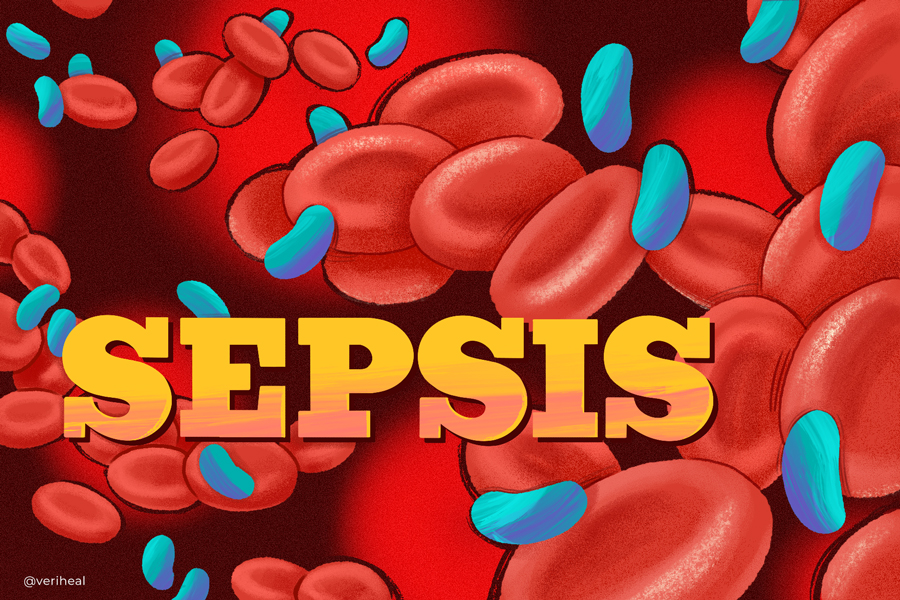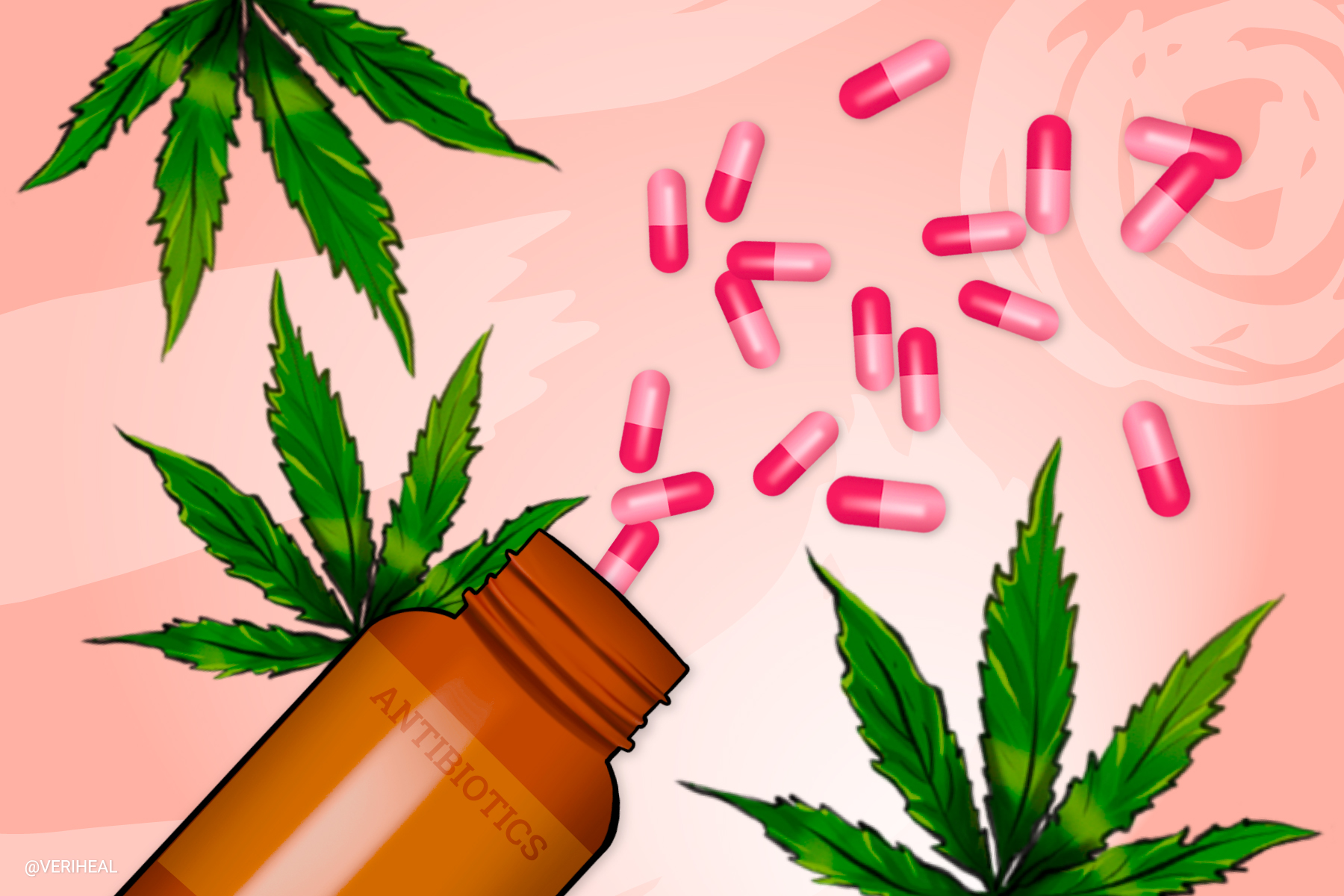Medical Marijuana and Sepsis: Possible Antibacterial Option?

- Cannabis and Sepsis Cellular Interactions
- Terpenes and Sepsis
- Notes on Cannabis and Infections
- Sepsis Terminology
- Stages of Sepsis
While some people believe that sepsis is merely a blood infection, it is much more than that. Sepsis results from an infection that has gotten out of control in the body, and it is considered a medical emergency. When the body is severely ill, processes like mental alertness, breathing, and organ functions suffer.
Several bench research studies have focused on cannabis and its ability to act as an antimicrobial and its ability to modulate the immune system, which may potentially help sepsis patients. Sepsis patients require a multidisciplinary approach for treatment, sometimes requiring critical care. Several definitions and scoring systems of sepsis exist (SIRS, Q-SOFA, etc) but still generally rely on the basic concept of identifying and treating the cause of sepsis, often but not always representing a body and blood-based infection.
Currently, scientists are working on understanding the vast cellular, genetic, and molecular mechanisms that are involved when an infection turns systemic (8). One of these biological systems researchers are focusing on is called the endocannabinoid system (ECS). Researchers believe that cannabinoids can potentially play a positive role in sepsis through modifying inflammation, oxidative stress, the immune system, and epigenetic expression.
Cannabis, its cannabinoids including Δ9-tetrahydrocannabinol (THC) and cannabidiol (CBD), and terpenes begin working in the body after they have been consumed and meet with the endocannabinoid system. The ECS is made from endocannabinoids, or fat-based neurotransmitters found in our bodies. These important neurotransmitters help our bodies with several processes including our perception of pain, modulating inflammation, and maintaining proper body temperature. They can also influence the way our immune system handles infections. Cannabis begins its work through cannabinoid receptors CB1 and CB2 that are in the central nervous system and throughout other areas of our body. Through the stimulation of these receptors, researchers have seen important changes in both biological and cellular mechanisms involved in sepsis (8).
Cannabis & Sepsis Cellular Interactions
Through the ECS and other cellular routes, researchers have found that cannabis may help several different bodily processes that are essential for proper recovery from sepsis and the original infection that caused it. Some of these mechanisms are detailed below.
Digestion
Because endocannabinoids respond quickly to cannabis when CB1 receptors are activated in the brain, feeding-regulation hormones are released (8). Additionally, both CB1 and CB2 receptors are responsible for the body’s metabolism and the release and control of glucose levels. Both cellular pathways are important in the process of keeping a patient from suffering from malnutrition so they can stay as strong as they can while recovering from sepsis.
Researchers often conduct medical experiments on mice because of similarities in bodily functions and processes. Keeping this in mind, a mice study was conducted focusing on slowing gastrointestinal motility with the use of CB2 receptors (22). This also slowed the intestines’ inflammatory response to sepsis, which was able to help slow the GI effects of sepsis. Alternatively, when digestive motility is slowed in sepsis, adverse intestinal reactions to the infection such as diarrhea may also be slowed with CBD according to limited septic mice studies (6).
Inflammation & Immune System Modulation
Cannabis is well known for its anti-inflammatory effects which typically result from its ability to influence how the immune system is functioning. Sepsis along with autoimmune diseases and arthritis can benefit from this effect. In sepsis, various inflammatory markers that cause cellular damage may be reduced with cannabinoids like CBD (8). Check out our page on inflammation to learn more about how this works.
Medical Cannabis as an Antimicrobial
A study found in The American Chemical Society and American Society of Pharmacognosy provides support that several of the cannabinoids found in medical marijuana have antibacterial properties (23). These researchers tested CBD, cannabigerol (CBG), cannabichromene (CBC), cannabinol (CBN), and THC against even antibiotic-resistant strains of the bacteria S. aureus. All cannabinoids in this study showed potent antibacterial activity (19).
Similarly, a 2020 study found that the cannabinoids listed above also showed potent antibacterial activity against methicillin-resistant staphylococcus aureus (MRSA) and inhibited the growth of MRSA biofilm (19). This is significant because MRSA is a very dangerous infection that often occurs in nursing homes and hospitals. Doctors are struggling to treat it, using more complex antibiotics to keep it from turning into sepsis. However, each time new “big gun” antibiotics are used, the chance for resistance increases, especially if patients do not finish the entire prescription.
Terpenes & Sepsis
There are several components of cannabis that have been tested and praised for their antimicrobial effects. Many researchers believe that it is hard to tell whether the scent profiles called terpenes or cannabinoids cause these effects (19). Additionally, many researchers believe that terpenes and cannabinoids work together to have a greater antimicrobial potential, due to an effect called the entourage effect. Cannabis contains over 120 cannabinoids and 200 different terpenes whose presence depends on the strain of cannabis that has been selected.
The following terpenes have scientifically been shown to have an antimicrobial effect on their own (19). Many of these terpenes are also active components of essential oils (19):
- Beta-caryophyllene
- Caryophyllene
- Myrcene
- Limonene
- Alpha-pinene
- Beta-pinene
It is important to note that the effect of terpenes on sepsis and infections is dependent on the type of bacteria that is causing the infection. A 2019 study looked into the effects of terpenes, or essential oils found in hemp. However, many of these terpenes are also present in cannabis, the form of plant that many use for medicinal and psychoactive effects. Though they tested a total of 17 different terpenes, this research found that antibacterial activity depends on the type of bacteria that it is put up against (24).
Of the two major categories of bacteria, Gram-positive and Gram-negative, this study found that many of the terpenes tested only had antimicrobial effects against gram-positive types of bacteria (24). In addition to the CBD that was tested, alpha-pinene, beta-pinene, and beta-myrcene were shown to be especially strong against Listeria and Enterococcus bacteria when compared to antibiotics including ampicillin and ciprofloxacin (19).
A similar study focusing on essential oils from hemp found that all the terpenes that were tested had a good effect on gram-positive Enterococcus and Streptococcus bacteria (25). Alpha-pinene was shown out of the typical terpenes tested (as opposed to man-made mixtures) to be the most effective essential oil against both Gram-positive and Gram-negative bacteria.
Notes on Cannabis & Infections
Just because there are studies that tout the benefits of cannabis cannabinoids and terpenes for treatment doesn’t mean that medical marijuana is currently a substitute for being treated by a medical professional for sepsis. Sepsis can be caused by a variety of different types of bacteria as well as results from infections in different parts of the body. It may also occur from severe heart, temperature, or brain dysfunction.
The treatment for sepsis is not a one-treatment fits all scenario, which is why emergency medical healthcare intervention is always recommended over medical cannabis. Proper antibiotics and fluids are classic mainstays of sepsis treatment, and even pressors or intensive care unit (ICU) stays are needed in severe critical cases. Currently, cannabinoids like THC are contraindicated in severe or critical illnesses due to hemodynamic (blood pressure) effects.
Sepsis Terminology
Unfortunately, many other labels relating to sepsis can be confusing and may be used interchangeably, though these terms are not completely interchangeable (26). Doctors have tried to sit down and agree on sepsis terms but often use different definitions anyway based on familiarity of training and scope of practice. These terms are important to understand if you or a loved one are seeking medical care for sepsis. The provider should be able to explain their reasoning for the diagnosis and treatment course.
Sepsis
Sepsis is defined as “life-threatening organ dysfunction caused by a dysregulated host response to infection (27).” In easier terms, it is a life-threatening condition that happens when the body responds to an infection and ends up injuring its own tissues and organs.
Septic Shock
Is a subset of sepsis in which circulatory system and cellular/metabolic abnormalities are serious enough to cause end-organ damage and substantially increase patient death (27).
Bacteremia
Some people use the term bacteremia interchangeably with sepsis, but they are different. Though bacteremia can lead to sepsis, it specifically refers to the presence of bacteria in the blood. A diagnosis of it does not mean you have sepsis, which is caused by a systemic inflammatory response (26).
Blood Poisoning
Blood poisoning is considered a “general (systemic) disease that is due to the presence and persistence of germs or their toxins in the bloodstream (28).” It is used interchangeably and can refer to bacteria in the blood, also known as bacteremia. It has also been used to describe sepsis and septicemia, but it is important to know this is a generalized medical term and not considered a specific diagnosis (27).
Septicemia
This term appears frequently in medical literature and can refer to bacteremia or sepsis. It is confusing because you must know which definition it is referring to. This is why it is no longer recommended to be used (26).
Stages of Sepsis
Sepsis is known for causing life-threatening organ dysfunction caused by infections that have become severe and lead to the body becoming dysregulated (26). In order to be diagnosed with this deadly blood infection patients must experience an altered mental status, a fast respiratory (breathing) rate greater than 22 breaths a minute, and low systolic blood pressure less than 100 mm Hg. When a patient has at least two symptoms, they are typically labeled as septic.
Many researchers believe that sepsis has three stages of infection, but not all believe that is the case. Commonly, doctors will still use older SIRS criteria instead of Q-SOFA to diagnose and define sepsis. Example stages of this alternative criteria that attempted to replace SIRS are detailed out below (26):
- Stage one (Q-SOFA ≥2) is the least severe and is associated with a 10% mortality rate for those who are hospitalized (27). Stage one usually consists of the following symptoms:
- Fever
- Increased heart rate
- Stage two usually includes the symptoms above as well as:
- Difficulty breathing
- Possible organs malfunctioning and organ failure
- Stage three, which is also known as septic shock, is the most severe stage. Septic shock is associated with a 40% mortality rate of those who were treated in the hospital (27). The symptoms are very severe and include the stages above in addition to:
Sepsis is the primary cause of death from infections, especially when it is not quickly recognized and treated (27). It can be caused by many types of infections in various locations in the body and several different types of bacteria. This is important to note because they can change how sepsis needs to be responded to.
Note: Veriheal does not intend to give this as professional medical advice. Do not attempt to self-diagnose, or prescribe treatment based on the information provided on this page. Always consult a physician before making any decision on the treatment of a medical condition.
1.Cassol-Jr, O. J., Comim, C. M., Silva, B. R., Hermani, F. V., Constantino, L. S., Felisberto, F., Petronilho, F., Hallak, J. E., De Martinis, B. S., Zuardi, A. W., Crippa, J. A. S., Quevedo, J., & Dal-Pizzol, F. (2010). Treatment with cannabidiol reverses oxidative stress parameters, cognitive impairment and mortality in rats submitted to sepsis by cecal ligation and puncture. Brain Research, 1348, 128–138. https://www.sciencedirect.com/science/article/abs/pii/S0006899310013582
2. Catalano, C., Seck, S., & Enia, G. (2011). Severe hyponatraemia during sepsis and Marijuana Addiction. Case Reports, 2011(mar28 1). https://casereports.bmj.com/content/2011/bcr.01.2011.3755
3. Centers for Disease Control and Prevention. (2021, August 17). What is sepsis? Centers for Disease Control and Prevention. Retrieved November 3, 2021, from https://www.cdc.gov/sepsis/what-is-sepsis.html
4. Chiu, R.G., et al. (2021) Cannabis Abuse and Perioperative Complications Following Inpatient Spine Surgery in the United States. Spine. https://journals.lww.com/spinejournal/Abstract/2021/06010/Cannabis_Abuse_and_Perioperative_Complications.9.aspx
5. Conceição Souza, M., & Cruz Rosas, E. (2019). Cannabinoid receptors as regulators of neutrophil activity in inflammatory diseases. Neutrophils. https://www.intechopen.com/chapters/64543
6. De Filippis, D., Iuvone, T., D’amico, A., Esposito, G., Steardo, L., Herman, A., Pelckmans, P., De Winter, B., & De Man, J. (2008). Effect of cannabidiol on sepsis-induced motility disturbances in mice: Involvement of cb1receptors and fatty acid amide hydrolase. Neurogastroenterology & Motility, 20(8), 919–927. https://onlinelibrary.wiley.com/doi/10.1111/j.1365-2982.2008.01114.x
7. Desai, R., Varma Chintalapalli Patta, H., Srikanth, S., Rida, T., Reddy Keesari, P., Asfeen, U., Yar Khan, N., Fatima, B., & Gandhi, Z. (2021). Cannabis use disorder: Friend or foe in septic shock and associated mortality among geriatric sepsis patients with chronic kidney or liver disease? Chest, 160(4). https://journal.chestnet.org/article/S0012-3692(21)02470-3/fulltext
8. Dinu, A. R., Rogobete, A. F., Bratu, T., Popovici, S. E., Bedreag, O. H., Papurica, M., Bratu, L. M., & Sandesc, D. (2020). Cannabis Sativa Revisited-Crosstalk between microRNA Expression, Inflammation, Oxidative Stress, and Endocannabinoid Response System in Critically Ill Patients with Sepsis. Cells, 9(2), 307. https://www.ncbi.nlm.nih.gov/pmc/articles/PMC7072707/
9. Editors, bioM. C. (2021, July 6). Researchers discover a new particle in the bloodstream of sepsis patients. bioMérieux Connection. Retrieved November 3, 2021, from https://www.biomerieuxconnection.com/2021/02/16/researchers-discover-a-new-particle-in-the-bloodstream-of-sepsis-patients/
10. Fagherazzi, E.V., Garcia, V.A., Maurmann, N. et al. Memory-rescuing effects of cannabidiol in an animal model of cognitive impairment relevant to neurodegenerative disorders. Psychopharmacology 219, 1133–1140 (2012). https://link.springer.com/article/10.1007/s00213-011-2449-3
11. Farha, M. A., El-Halfawy, O. M., Gale, R. T., MacNair, C. R., Carfrae, L. A., Zhang, X., Jentsch, N. G., Magolan, J., & Brown, E. D. (2020). Uncovering the hidden antibiotic potential of cannabis. ACS Infectious Diseases, 6(3), 338–346. https://pubs.acs.org/doi/10.1021/acsinfecdis.9b00419
12. Gui, H., Sun, Y., Luo, Z. M., Su, D. F., Dai, S. M., & Liu, X. (2013). Cannabinoid receptor 2 protects against acute experimental sepsis in mice. Mediators of inflammation, 2013, 741303. https://www.ncbi.nlm.nih.gov/pmc/articles/PMC3679685/
13. Gunasekaran, K., Voruganti, D. C., Singh Rahi, M., Elango, K., Ramalingam, S., Geeti, A., & Kwon, J. (2021). Trends in prevalence and outcomes of cannabis use among chronic obstructive pulmonary disease hospitalizations: A nationwide population-based study 2005–2014. Cannabis and Cannabinoid Research, 6(4), 340–348. https://www.liebertpub.com/doi/full/10.1089/can.2020.0133
14. Hernández-Cervantes, R., Méndez-Díaz, M., Prospéro-García, Ó., & Morales-Montor, J. (2017). Immunoregulatory role of cannabinoids during infectious disease. Neuroimmunomodulation, 24(4-5), 183–199. https://www.karger.com/Article/Fulltext/481824
15. Meza, A., & Lehmann, C. (2018). Betacaryophyllene – a phytocannabinoid as potential therapeutic modality for human sepsis? Medical Hypotheses, 110, 68–70. https://www.sciencedirect.com/science/article/abs/pii/S0306987717308617
16. Nichols, J. M., & Kaplan, B. L. F. (2020). Immune responses regulated by Cannabidiol. Cannabis and Cannabinoid Research, 5(1), 12–31. https://www.liebertpub.com/doi/full/10.1089/can.2018.0073
17. Ruiz-Valdepeñas, L., Martínez-Orgado, J.A., Benito, C. et al. Cannabidiol reduces lipopolysaccharide-induced vascular changes and inflammation in the mouse brain: an intravital microscopy study. J Neuroinflammation 8, 5 (2011). https://jneuroinflammation.biomedcentral.com/articles/10.1186/1742-2094-8-5
18. Sardinha, J., Kelly, M. E., Zhou, J., & Lehmann, C. (2014). Experimental cannabinoid 2 receptor-mediated immune modulation in sepsis. Mediators of Inflammation, 2014, 1–7. https://www.hindawi.com/journals/mi/2014/978678/
19. Schofs, L., Sparo, M. D., & Sánchez Bruni, S. F. (2021). The antimicrobial effect behind Cannabis Sativa. Pharmacology Research & Perspectives, 9(2). https://bpspubs.onlinelibrary.wiley.com/doi/full/10.1002/prp2.761
20. Szekely, Y., Ingbir, M., Bentur, O.S. et al. Natural cannabinoids suppress the cytokine storm in sepsis-like in vitro model. Eur Cytokine Netw 31, 50–58 (2020). https://link.springer.com/article/10.1684/ecn.2020.0445
21. What is sepsis. Sepsis Alliance. (2021, August 4). Retrieved November 3, 2021, from https://www.sepsis.org/sepsis-basics/what-is-sepsis/
22. Lehmann, C., Kianian, M., Zhou, J., Küster, I., Kuschnereit, R., Whynot, S., Hung, O., Shukla, R., Johnston, B., Cerny, V., Pavlovic, D., Spassov, A., & Kelly, M. E. (2012). Cannabinoid receptor 2 activation reduces intestinal leukocyte recruitment and systemic inflammatory mediator release in acute experimental sepsis. Critical care (London, England), 16(2), R47. https://www.ncbi.nlm.nih.gov/pmc/articles/PMC3681373/
23. Appendino, G., Gibbons, S., Giana, A., Pagani, A., Grassi, G., Stavri, M., Smith, E., & Rahman, M. M. (2008). Antibacterial cannabinoids from cannabis sativa: A structure−activity study. Journal of Natural Products, 71(8), 1427–1430. https://pubs.acs.org/doi/10.1021/np8002673
24. Iseppi, R., Brighenti, V., Licata, M., Lambertini, A., Sabia, C., Messi, P., Pellati, F., & Benvenuti, S. (2019). Chemical Characterization and evaluation of the antibacterial activity of essential oils from fibre-type Cannabis Sativa L. (hemp). Molecules, 24(12), 2302. https://www.mdpi.com/1420-3049/24/12/2302/htm
25. Nissen, L., Zatta, A., Stefanini, I., Grandi, S., Sgorbati, B., Biavati, B., & Monti, A. (2010). Characterization and antimicrobial activity of essential oils of industrial hemp varieties (cannabis sativa L.). Fitoterapia, 81(5), 413–419. https://www.sciencedirect.com/science/article/abs/pii/S0367326X09002780?via%3Dihub
26. Davis, C. P. (2021, July 26). Sepsis (septicemia) definition, treatment, causes, stages & diagnosis. MedicineNet. Retrieved December 5, 2021, from https://www.medicinenet.com/sepsis/article.htm
27. Singer, M., Deutschman, C. S., Seymour, C. W., Shankar-Hari, M., Annane, D., Bauer, M., Bellomo, R., Bernard, G. R., Chiche, J.-D., Coopersmith, C. M., Hotchkiss, R. S., Levy, M. M., Marshall, J. C., Martin, G. S., Opal, S. M., Rubenfeld, G. D., van der Poll, T., Vincent, J.-L., & Angus, D. C. (2016). The third international consensus definitions for sepsis and septic shock (sepsis-3). JAMA, 315(8), 801. https://jamanetwork.com/journals/jama/fullarticle/249288
28. MedicineNet. (2021, March 29). Medical definition of blood poisoning. MedicineNet. Retrieved December 5, 2021, from https://www.medicinenet.com/blood_poisoning/definition.htm








